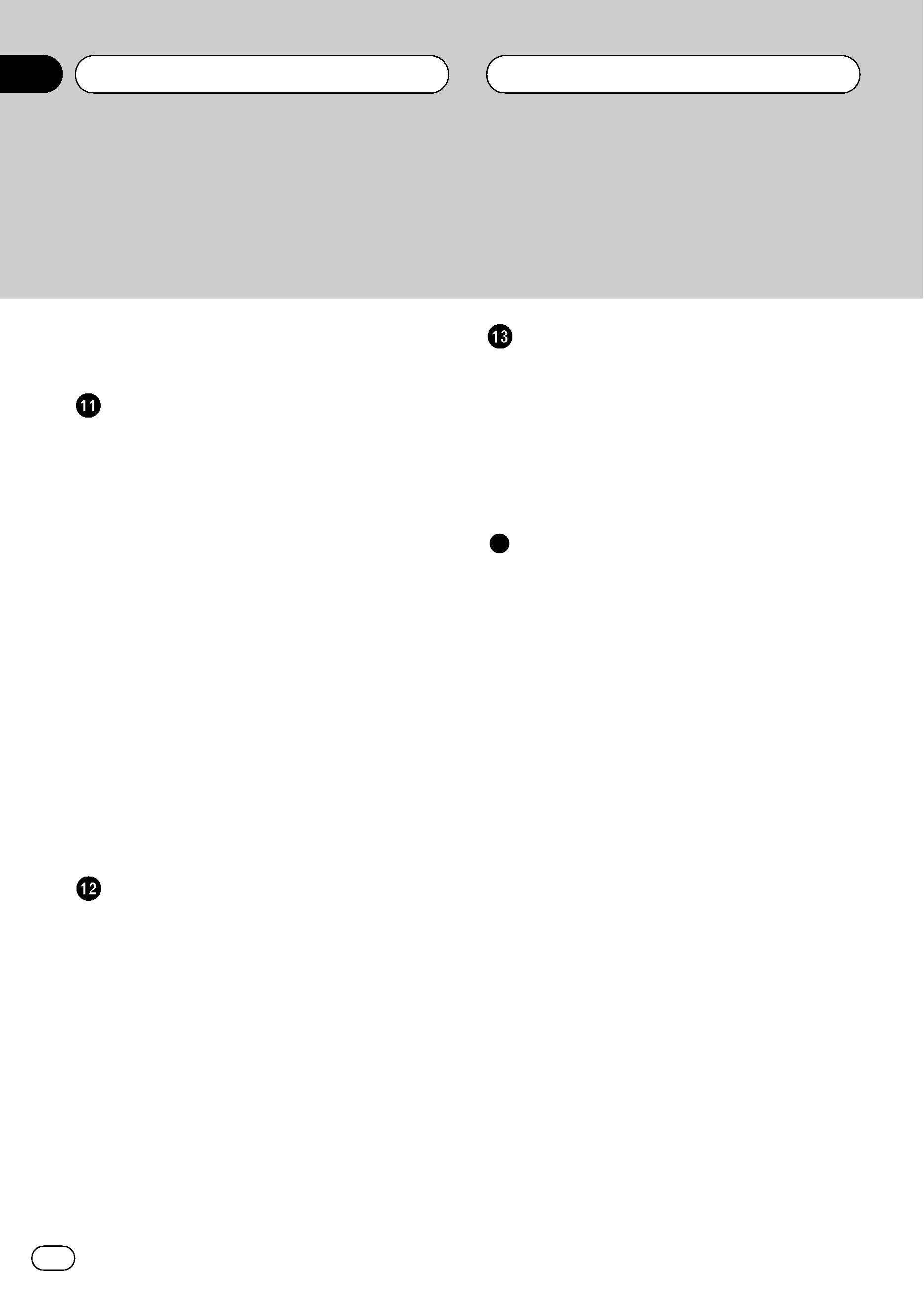
Operation Manual
Mode demploi
Multi-CD control High power CD/MP3/WMA player
with FM/AM tuner
Syntoniseur FM/AM et lecteur de CD/MP3/WMA,
Puissance élevée, avec contrôleur pour lecteur de
CD à chargeur
DEH-P80MP
English
Français

Thank you for buying this Pioneer product.
Please read through these operating instructions so you will know how to operate
your model properly. After you have finished reading the instructions, keep this man-
ual in a safe place for future reference.
Before You Start
Information to User 6
For Canadian model 6
About this unit 6
About this manual 6
After-sales service for Pioneer products 6
Product registration 6
Precautions 7
Features 7
About WMA 7
About the XMREADY mark 8
Resetting the microprocessor 8
Protecting your unit from theft 8
Removing the front panel 9
Attaching the front panel 9
About the demo mode 9
Reverse mode 9
Feature demo 10
Use and care of the remote control 10
Installing the battery 10
Using the remote control 10
FUNCTION button and AUDIO
button 10
Whats What
Head unit 12
Remote control 13
Basic Operations
Turning the unit on 14
Selecting a source 14
Loading a disc 14
Adjusting the volume 15
Turning the unit off 15
Tuner
Listening to the radio 16
Introduction of advanced tuner
operation 17
Storing broadcast frequencies 17
Recalling broadcast frequencies 17
Storing the strongest broadcast
frequencies 18
Selecting stations from the preset channel
list 18
Tuning in strong signals 18
Built-in CD Player
Playing a CD 20
Selecting a track directly 20
Introduction of advanced built-in CD player
operation 21
Repeating play 21
Playing tracks in a random order 21
Scanning tracks of a CD 22
Pausing CD playback 22
Selecting the search method 22
Searching every 10 tracks in the current
disc 22
Using compression and BMX 23
Entering disc titles 23
Using CD TEXT functions 24
Displaying titles on CD TEXT
discs 24
Scrolling titles in the display 24
Selecting tracks from the track title
list 24
MP3/WMA/WAV Player
Playing MP3/WMA/WAV 25
Selecting a track directly in the current
folder 26
Introduction of advanced built-in CD player
(MP3/WMA/WAV) operation 26
Repeating play 27
Playing tracks in a random order 27
Scanning folders and tracks 27
Pausing MP3/WMA/WAV playback 28
Contents
En
2

Selecting the search method 28
Searching every 10 tracks in the current
disc 28
Switching the tag display 28
Using compression and BMX 29
Displaying text information on MP3/WMA/
WAV disc 29
When playing back an MP3/WMA
disc 29
When playing back a WAV disc 29
Scrolling text information in the display 30
Selecting tracks from the file name list 30
Multi-CD Player
Playing a CD 31
Selecting a track directly 31
50-disc multi-CD player 32
Introduction of advanced multi-CD player
operation 32
Repeating play 33
Playing tracks in a random order 33
Scanning CDs and tracks 33
Pausing CD playback 34
Using ITS playlists 34
Creating a playlist with ITS
programming 34
Playback from your ITS playlist 34
Erasing a track from your ITS
playlist 35
Erasing a CD from your ITS
playlist 35
Using disc title functions 35
Entering disc titles 35
Selecting discs from the disc title
list 36
Using CD TEXT functions 36
Displaying titles on CD TEXT
discs 36
Scrolling titles in the display 37
Selecting tracks from the track title
list 37
Using compression and bass emphasis 37
TV tuner
Watching the TV tuner 38
Introduction of advanced TV tuner
operation 39
Storing broadcast stations 39
Recalling broadcast stations 39
Storing the strongest broadcast stations
sequentially 39
Selecting stations from the preset channel
list 40
DVD Player
Playing a disc 41
Selecting a disc 41
Introduction of advanced DVD player
operation 42
Repeating play 42
Pausing disc playback 42
Playing tracks in a random order 43
Scanning tracks of a CD 43
Using ITS playlist and disc title functions 43
Using disc title functions 43
Entering disc titles 43
XM tuner
Listening to the XM 44
Introduction of advanced XMtuner
operation 45
Switching the XMdisplay 45
Storing and recalling broadcast stations 45
Swiching the XMchannel select setting 45
Selecting the channel in the channel
category 46
Selecting the XMchannel directly 46
Display the ID code 46
En
3
English
Contents

Channel number select setting 46
Channel category select setting 46
Audio Adjustments
Introduction of audio adjustments 47
Compensating for equalizer curves (EQ-
EX) 47
Setting the sound focus equalizer
(SFEQ) 48
Using balance adjustment 48
Using the equalizer 49
Recalling equalizer curves 49
Adjusting equalizer curves 49
Fine-adjusting equalizer curve 49
Adjusting bass and treble 50
Adjusting loudness 50
Using subwoofer output 51
Adjusting subwoofer settings 51
Using nonfading output 51
Adjusting nonfading output level 52
Using the high pass filter 52
Adjusting source levels 52
Using automatic sound levelizer 53
Initial Settings
Adjusting initial settings 54
Setting the clock 54
Switching the warning tone 54
Switching the auxiliary setting 55
Switching the dimmer setting 55
Adjusting the brightness 55
Setting the rear output and subwoofer
controller 55
Switching the telephone muting/
attenuation 56
Switching the motion screen 56
Switching the Ever Scroll 56
Switching the flap auto open 57
Other Functions
Turning the clock display on or off 58
Using the AUX source 58
Selecting AUX as the source 58
Setting the AUX title 58
Using different entertainment displays 59
Rewriting the entertainment displays 59
Using the PGMbutton 60
Additional Information
Understanding built-in CD player error
messages 61
Understanding error message on rewriting
the entertainment displays 61
CD player and care 61
CD-R/CD-RW discs 62
MP3, WMA and WAV files 62
MP3 additional information 63
WMA additional information 63
WAV additional information 64
About folders and MP3/WMA/WAV files 64
Terms 65
Specifications 67
Contents
En
4

Selecting fine audio equipment such as the unit you've just purchased is only the start of your
musical enjoyment. Now it's time to consider how you can maximize the fun and excitement your
equipment offers. This manufacturer and the Electronic Industries Association's Consumer
Electronics Group want you to get the most out of your equipment by playing it at a safe level. One
that lets the sound come through loud and clear without annoying blaring or distortion--and, most
importantly, without affecting your sensitive hearing.
Sound can be deceiving. Over time your hearing "comfort level" adapts to higher volumes of
sound. So what sounds "normal" can actually be loud and harmful to your hearing. Guard against
this by setting your equipment at a safe level BEFORE your hearing adapts.
To establish a safe level:
· Start your volume control at a low setting.
· Slowly increase the sound until you can hear it comfortably and clearly, and without distortion.
Once you have established a comfortable sound level:
· Set the dial and leave it there.
Taking a minute to do this now will help to prevent hearing damage or loss in the future. After
all, we want you listening for a lifetime.
We Want You Listening For A Lifetime
Used wisely, your new sound equipment will provide a lifetime of fun and enjoyment. Since
hearing damage from loud noise is often undetectable until it is too late, this manufacturer and the
Electronic Industries Association's Consumer Electronics Group recommend you avoid prolonged
exposure to excessive noise. This list of sound levels is included for your protection.
Decibel
Level
Example
30
Quiet library, soft whispers
40
Living room, refrigerator, bedroom away from traffic
50
Light traffic, normal conversation, quiet office
60
Air conditioner at 20 feet, sewing machine
70
Vacuum cleaner, hair dryer, noisy restaurant
80
Average city traffic, garbage disposals, alarm clock at two feet
THE FOLLOWING NOISES CAN BE DANGEROUS UNDER CONSTANT EXPOSURE
90
Subway, motorcycle, truck traffic, lawn mower
100
Garbage truck, chain saw, pneumatic drill
120
Rock band concert in front of speakers, thunderclap
140
Gunshot blast, jet plane
180
Rocket launching pad
Information courtesy of the Deafness Research Foundation.
En
5
English
